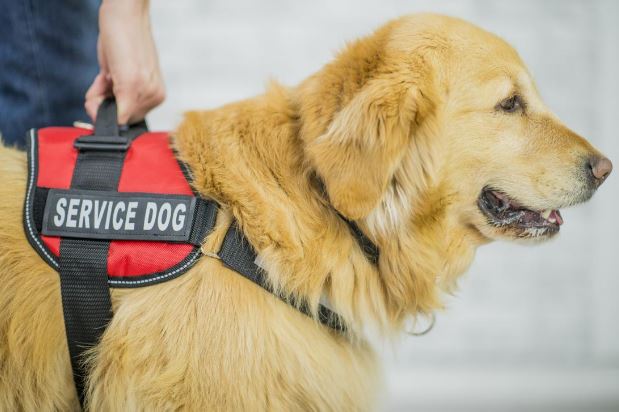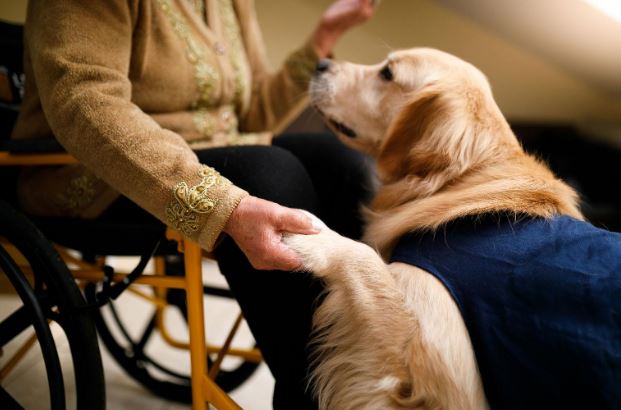A service dog is trained to support people with impairments and make it easier for them to engage in daily activities. A service dog promotes more independence in the life of a disabled person. A service dog is a dog which is individually trained to do execute duties for a person with a handicap” by the Americans with Disabilities Act (ADA). Service dogs can provide their partners with a sense of freedom. According to federal law (The Americans with Disabilities Act), a person partnered with a service dog has full public access rights and is permitted to bring their dog into all public venues. Service dogs and their human partners are never separated in this way!
A service dog may be helpful to people with the kinds of disabilities that are mentioned above. The ADA defines “disability” as a physical or mental impairment that significantly restricts one or more major life activities, including those with a history of such an impairment and those considered to have one by others. According to the ADA, it is illegal to discriminate against people with disabilities in the workplace, state and local governments, public places, private businesses, transportation, and telecommunications.
A service dog is taught to carry out a specific task that lessens a person’s impairment. The task the dog completes is directly tied to the impairment of its owner. This article provides all the brief information you need before having a service dog.
What Functions does a Service Dog Have?
Service dogs offer greater freedom, happiness, contentment, assurance, safety, and affection. Our service canines are prepared to assist people with a variety of disabilities. CPL trains service dogs to help people with disabilities such as poor balance, trouble using their hands or arms, health-related weariness, seizure/cardiac syncope, diabetes, and blood pressure concerns.
Service dogs are properly and thoroughly taught to carry out a specific task for their owner, who may have a mental, physical, or emotional handicap. For instance, a seizure response service dog will respond appropriately and call for assistance if its owner has a spontaneous seizure. Service dogs are not considered pets but workers because of this significant purpose. Any pet that can calm a person with an emotional handicap, such as sadness or anxiety, is an ESA. They serve only as companions through difficult times of emotion and are not trained to carry out any task to help their owners.
Since they are essential for their handlers’ safety, wellbeing, and routine responsibilities, service dogs are legally protected under the ADA. For instance, a landlord cannot reject a tenant because of a service dog because service animals are considered to be an extension of the individual. ESAs are not given the same level of legal protection as service dogs. Even though landlords cannot charge you a pet fee or deny you a rental because of an ESA, many public spaces, including restaurants, supermarkets, and hospitals, do not allow pets.
Consider registering your service dog
If you’ve ever seen a pet accompanying its owner out in public, you’ve probably caught a glimpse of the dog sporting a vest or the owner carrying a card with a registration number.
Although the ADA does not call for any specific licensing or service dog registration, many owners purchase an ID that can be worn in various places, such as a vest around the dog’s body or a lanyard around the owner’s neck, or elsewhere. Why? The explanation of why you are bringing a dog into this or that place, which most likely does not allow dogs, can be condensed into a single gesture with the ability to flash an ID.
Not everyone is familiar with the rights guaranteed to people with disabilities stated in the ADA, especially the language about service dogs. Unfortunately, some individuals can even be rude or impatient with owners who may find it challenging to explain their rights or the reason for their service dog if they, for example, suffer from a speech impairment. Potential stress, conflict, and discrimination are reduced when your dog is certified by a group like ADA Service Dog Registration of America and receives an ID card.
How is a Service Dog Trained?
Each service dog in the Canine Partners for Life program spends two years training to be a working dog. Every CPL service dog receives a year of training that includes basic obedience instruction and socialization in public.
More sophisticated service skills are the main focus of the second year of training. Each CPL dog will undergo testing in their second year to see if they naturally have the ability to alert to medical issues. Each dog’s skills are customized over the final few months of training to fit the requirements of its eventual mate.
A CPL dog must be an inherently healthy working companion with a stable disposition to complete the entire training program. A few popular dog breeds are more likely to possess the qualities needed in companion dogs for disabled people, while great care is taken to choose only the most suitable dogs for this level of work.
Where Can I Take My Service Dog?
According to the Americans with Disabilities Act, state and local governments, businesses, and nonprofit organizations that provide services to the public must provide service dogs, service animals, and their handlers with full access to all areas of their facilities open to the general public. This policy undoubtedly has some restrictions; for instance, a service animal is permitted in hospital waiting areas but not in operating rooms. Alternatively, the restaurant may permit the service animal inside, but not in the kitchen, where food is being cooked. A service dog may fly with its owner thanks to the Air Carrier Access Act (ACAA). Before taking off, inquire about assistance dog policies with your airline.
When a service dog is deemed a service dog
Once it has been taught to help a person with a disability, a dog or other animal is regarded as a service animal. A seeing-eye dog is the most prevalent example, but service animals help people with a wide range of physical and mental impairments. Even medical alert canines trained as service animals may tell when their handlers’ insulin levels have fallen. Service dogs are excellent companions for people with disabilities.
Conclusion:
The use of service dogs has increased, and so too have the potential issues that can arise from a lack of knowledge regarding service dog training, job duties, and accessibility to public facilities. A service dog was often a guide dog that helped someone with hearing or vision impairment. You may find a basic explanation of service dogs and their functions in this article.


